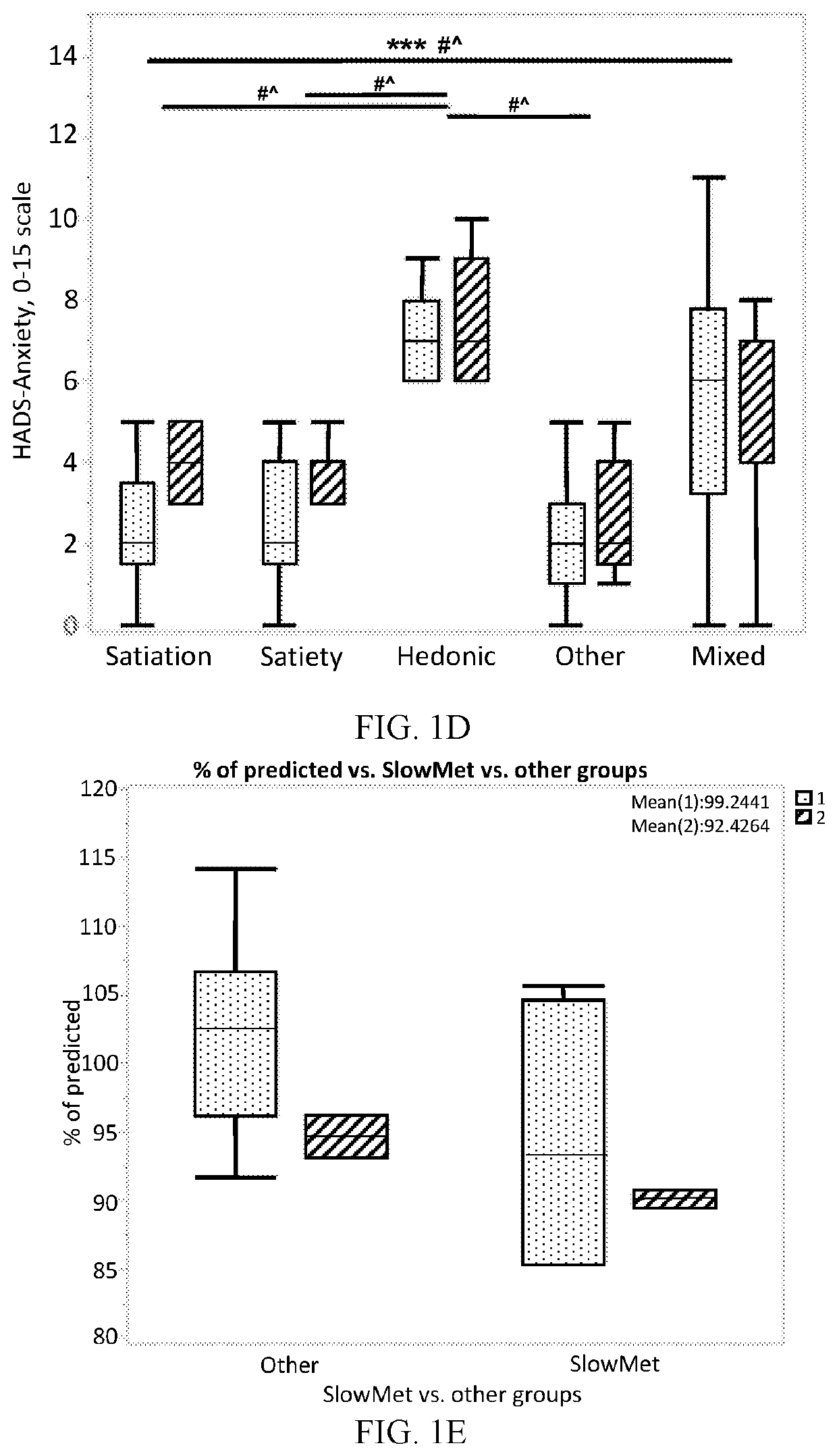Methods and materials for assessing and treating obesity
a technology of obesity and methods, applied in the direction of instruments, peptide/protein ingredients, metabolic disorders, etc., can solve the problem of increasing the risk of numerous diseases
- Summary
- Abstract
- Description
- Claims
- Application Information
AI Technical Summary
Benefits of technology
Problems solved by technology
Method used
Image
Examples
example 1
Identification of Obesity Biomarkers
[0058]Obesity phenotypes were associated with higher BMI, distinguish obesity phenotypes, and can be used to predict responsiveness to obesity pharmacotherapy and endoscopic devices (see, e.g., Acosta et al., 2015 Gastroenterology 148:537-546). In this study, biomarkers specific to each obesity phenotype were identified using metabolomics.
[0059]The overall cohort demographics [median (IQR)] were age 36 (28-46) years, BMI 35 (32-38) kg / m2, 75% females, 100% Caucasians. The groups based on phenotype > or <75% ile were not statistically different for body weight, waist circumference, hip circumference, fasting glucose. The group distribution in this cohort was: abnormal satiation (16%), abnormal satiety (16%), abnormal hedonic / psych (19%), slow metabolism / energy expenditure (32%), and mixed group (17%) (FIG. 1A). FIGS. 1B-E illustrate summarize characteristics of the quantitative changes in the subgroups: the satiation group consumed 591 (60%) more c...
example 2
Obesity Phenotypes and Intervention Responsiveness
[0158]Obesity is a chronic, relapsing, multifactorial, heterogeneous disease. The heterogeneity within obesity is most evident when assessing treatment response to obesity interventions, which are generally selected based on BMI. These standard approaches fail to address the heterogeneity of obesity. As described in Example 1, obesity phenotypes were associated with higher BMI, distinguish obesity phenotypes. This Example shows that obesity phenotypes respond differently to specific interventions (e.g., pharmacological interventions). Obesity-related phenotypes were evaluated to facilitate the understanding of obesity pathophysiology, and identify sub-groups within the complex and heterogeneous obese population. A novel classification based on identifying actionable traits in the brain-gut axis in humans (see, e.g., Acosta et al., 2015 Gastroenterology 148:537-546 e534; and Camilleri et al., 2016 Gastrointest Endosc. 83:48-56) was ap...
example 3
Obesity Phenotypes and Patient Sub Populations
[0180]To validate further the applicability of the obesity phenotypes, the fact that each sub-group may have unique abnormalities compared to the other groups when tested with previously validated or reported findings in common obesity was interrogated.
[0181]The model described above was run independently for female and male sub-populations of patients. Characteristics of a complete population is as denoted in Table 11.
TABLE 11Whole Cohort (181 patients).#pts w / #pts w / TraitMean + SD>2 SD# ptsMedian>90%trait% pts>75%trait% ptsHADS-A3.4 + 2.5917372916%64625%HADS-D1.54 + 1.74520142514%32413%VTF706 + 2961337963010802112%9004424%MTV1286 + 417 214213127218962413%15394625%VAS - Full70 + 14−40272481810%614424%SGE T1 / 299.5 + 25.8−4759870.817 9%814324%Buffett917 + 29516041691613572313%11844424%
[0182]Unique analytes were identified when this cohort was separated into female and male sub-populations as shown in Table 12 and Table 13.
TABLE 12Female s...
PUM
| Property | Measurement | Unit |
|---|---|---|
| total body weight | aaaaa | aaaaa |
| waist circumference | aaaaa | aaaaa |
| total body weight | aaaaa | aaaaa |
Abstract
Description
Claims
Application Information
 Login to View More
Login to View More - R&D
- Intellectual Property
- Life Sciences
- Materials
- Tech Scout
- Unparalleled Data Quality
- Higher Quality Content
- 60% Fewer Hallucinations
Browse by: Latest US Patents, China's latest patents, Technical Efficacy Thesaurus, Application Domain, Technology Topic, Popular Technical Reports.
© 2025 PatSnap. All rights reserved.Legal|Privacy policy|Modern Slavery Act Transparency Statement|Sitemap|About US| Contact US: help@patsnap.com



